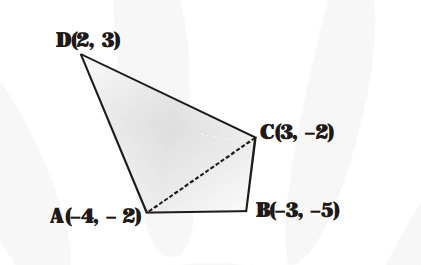Question.
Find the area of the quadrilateral whose vertices taken in order are (–4, –2), (–3, –5), (3, –2) and (2, 3).
Find the area of the quadrilateral whose vertices taken in order are (–4, –2), (–3, –5), (3, –2) and (2, 3).
Solution:
Join A and C. The given points are
$\mathrm{A}(-4,-2), \mathrm{B}(-3,-5), \mathrm{C}(3,-2)$ and $\mathrm{D}(2,3)$

Area of $\triangle \mathrm{ABC}$
$=\frac{\mathbf{1}}{\mathbf{2}}[(-4)(-5+2)-3(-2+2)+3(-2+5)]$
$=\frac{\mathbf{1}}{\mathbf{2}}[12+0+9]=\frac{\mathbf{2 1}}{\mathbf{2}}=10.5$ sq. units
Area of $\Delta \mathrm{ACD}$
$=\frac{1}{2}[(-4)(-2-3)+3(3+2)+2(-2+2)]$
$=\frac{\mathbf{1}}{\mathbf{2}}\left[20+15 \mid=\frac{\mathbf{3 5}}{\mathbf{2}}=17.5\right.$ sq. units.
Area of quadrilateral ABCD
$=\operatorname{ar}(\Delta \mathrm{ABC})+\operatorname{ar}(\Delta \mathrm{ACD})$
$=(10.5+17.5) \mathrm{sq} .$ units $=28 \mathrm{sq} .$ units
Join A and C. The given points are
$\mathrm{A}(-4,-2), \mathrm{B}(-3,-5), \mathrm{C}(3,-2)$ and $\mathrm{D}(2,3)$

Area of $\triangle \mathrm{ABC}$
$=\frac{\mathbf{1}}{\mathbf{2}}[(-4)(-5+2)-3(-2+2)+3(-2+5)]$
$=\frac{\mathbf{1}}{\mathbf{2}}[12+0+9]=\frac{\mathbf{2 1}}{\mathbf{2}}=10.5$ sq. units
Area of $\Delta \mathrm{ACD}$
$=\frac{1}{2}[(-4)(-2-3)+3(3+2)+2(-2+2)]$
$=\frac{\mathbf{1}}{\mathbf{2}}\left[20+15 \mid=\frac{\mathbf{3 5}}{\mathbf{2}}=17.5\right.$ sq. units.
Area of quadrilateral ABCD
$=\operatorname{ar}(\Delta \mathrm{ABC})+\operatorname{ar}(\Delta \mathrm{ACD})$
$=(10.5+17.5) \mathrm{sq} .$ units $=28 \mathrm{sq} .$ units
Click here to get exam-ready with eSaral
For making your preparation journey smoother of JEE, NEET and Class 8 to 10, grab our app now.
